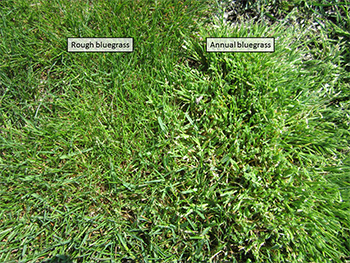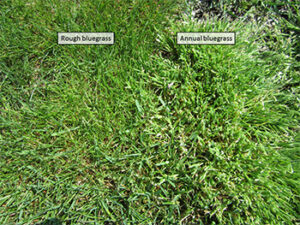Poa Annua and Poa Trivalis
Are they grass? Are they a weed?
Well, the answer is…. That’s up to you.
When it comes to grass, Poa Annua and Trivialis technically fall in the category as they are both strains of Bluegrass. However, if you ask homeowners who find either in their lawn, many may argue that they are weeds. At the very least they find them bothersome to the uniformity of their lawn. Let’s get into the facts about these plants so we can better understand these strains of Bluegrass and what can be done to manage them.
Poa Annua
Poa Annua (Annual Bluegrass) is a cool season annual grass that germinates in fall and grows slowly through the winter. It’s especially noticeable in May and June because of its prolific seedhead production and it can sometimes be confused as crabgrass. The dropped seeds lie dormant until the cool weather returns in the fall, starting the cycle again. In areas of stressed turfgrass, the annual bluegrass will out-compete it and thrive. It is almost a certainty that you have Poa annua in your lawn: it is one of the five most widely distributed plants in the world. With regular control measures, annual bluegrass can be contained but is rarely eliminated.
Poa Trivialis
Poa Trivialis (Rough Bluegrass), on the other hand, is a perennial cool season grass. It is more noticeable in the late winter/early spring and rarely produces a seedhead when mowed. Its tolerance for shade makes it particularly aggressive in shady lawns. The light green grass creates thick mats of stems, overpowering desirable grasses in the lawn. Because of the color contrast and rapid growth, it is aesthetically unappealing. With the summer heat the Poa Trivialis dies back, leaving bare soil. The timing and appearance of the die back can look like a fungal infection and is often mistakenly treated as such. Poa Trivialis may appear to be gone, but the plant’s stems survive underground waiting for cool weather to return and will pop up again in the fall.
You’re not alone in your fight; golf courses have just as much trouble with Poa as homeowners. Instead of fighting it, many courses have turned its characteristics into a benefit. This weed grass is intentionally used in some applications as a winter overseed, because it makes a good winter putting surface for golf greens. They’ll then transition back to Bermuda or Bentgrass for the summer.
Control of Poa in lawns
Control of either type of Poa in lawns is difficult because, like grasses, they rely on both chemical and cultural control. Chemically, the difficulty arises in the fact that many herbicides that will kill these weed grasses will kill lawn grass as well. This means that a combination of weed control methods must be used and maintained over an extended period for continued control. There is no quick and easy fix for weed grass problems, particularly when those weed grasses are the undesirable bluegrasses. If you attempt to control with a non-selective herbicide like glyphosate (Roundup) it must be done in the spring. The resulting bare areas must be reseeded soon after, provided you have adequate irrigation to support young grass plants through summer. In doing this, crabgrass controls need to be avoided to not affect seed germination. This can result in crabgrass issues through the summer and it’s possible that a lot of the young grass may die off with the heat.
You may read elsewhere that pre-emergents are recommended in the fall, and yes, that can be effective, but it is not the case for our climate here in Southern New Jersey. Areas that have predominantly warm season grasses are where this practice is best incorporated. Unfortunately for us, the fall is the prime growing season and as stated before, pre-emergents will adversely affect any seeding done by us or the homeowner.
Cultural practices and control
There are a few cultural practices that can reduce the chances of weedy bluegrasses becoming established in your lawn, but they will not fix an existing problem. Primarily this means that maintaining a thick and healthy lawn will help out-compete these grasses and other weeds. Creating competition is best achieved by seeding in the fall with desirable grasses. For New Jersey climate, Tall Fescue is the best way to go, but some homeowners or DIYers may have their preferred mix. Here’s where things get even tougher – you will find Poa unintentionally in seed mixes. Due to the size of the seeds, Poa cannot be removed in the screening process that normally removes unwanted seeds; it has already contaminated a large portion of grass seed blends, most notably in shade mixes. The seed is also often missed during visual seed quality testing due to its similarity to the seeds of bluegrass. For these reasons it has become a common contaminant in grass seed blends and is will remain so for the foreseeable future.
The other cultural controls are mowing, watering, and fertilizing. Be careful not to mow too short, as taller turf grass shades the soil and prevents weed seed germination (it helps with all weed seeds, not just annual bluegrass). When grass is cut too short it becomes stressed and less able to compete against weeds. Watering should be done deeply and infrequently, preferably twice weekly (a third weekly watering can be added in drought or heatwaves). Frequent, shallow watering benefits shallow-rooted annual bluegrass while inhibiting the development of deep, healthy roots on fescue and other desirable turf grasses. Low areas that remain wet for extended periods also encourage weed bluegrasses, as does a shady lawn. Finally, proper rates and timing of fertilizer applications will help strengthen your lawn while not overly stimulating undesirable weeds.
Call GSU for a game plan
With all that in mind, if you find Poa to be a nuisance in your lawn and want it controlled, be prepared to put up a fight. But don’t be discouraged, GSU is here to help! Control can be achieved with a solid game plan and staying on the same page, path, campaign… whatever you want to call it. We are committed to continuously researching new products and methods of lawn care to get you the best results possible. Our goal here at GSU is to develop new practices and programs to offer more solutions for a variety of ever-evolving issues that face our lawns. If this stuck a chord with you and want to learn more, give us a call today!




